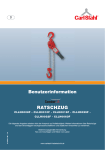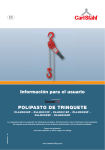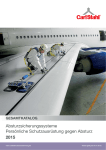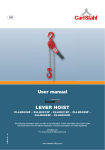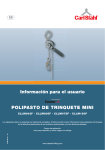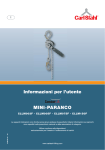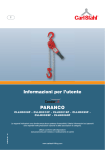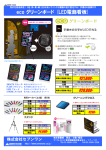Download User manual CHAIN BLOCK - Carl Stahl Hebetechnik
Transcript
GB User manual CHAIN BLOCK CLCB005F - CLCB010F - CLCB015F - CLCB030F - CLCB050F The following information does not claim to be exhaustive. Further information about chain blocks should be taken from the relevant employers’ insurance association and state regulations. Intended use: For anchoring and lifting loads only 01 - 28/10/2014 www.carlstahl-lifting.com NOTE! For incomplete machines, the assembly/installation instructions can be found in the ‘Assembly’ section. © by Carl Stahl GmbH Tobelstr. 2 ∙ D-73079 Suessen (Germany) www.carlstahl.com The original operating manual is in German. Versions in other languages have been translated from the German original. A copy can be requested in writing from Carl Stahl. Subject to modifications. Contents 1 Information ..................................................................................................................4 2 2.1 2.2 2.3 2.4 2.5 Safety............................................................................................................................4 Warnings and icons ......................................................................................................4 Operator duties of care ................................................................................................5 Requirements to be met by operating personnel..........................................................6 Intended use..................................................................................................................6 Basic safety measures ..................................................................................................7 3 3.1 3.2 3.3 Transport and storage ................................................................................................8 Transport ......................................................................................................................8 Securing for transportation ..........................................................................................8 Storage ..........................................................................................................................8 4 4.1 4.2 4.3 4.4 Description ..................................................................................................................9 Application areas ..........................................................................................................9 Structure........................................................................................................................9 Functional description ..................................................................................................9 Important components ..................................................................................................9 5 Specifications ............................................................................................................10 Installation..................................................................................................................10 6 6.1 Trolley ..........................................................................................................................10 6.2 Tools ............................................................................................................................11 7 Operation....................................................................................................................11 2 www.carlstahl-lifting.com Commissioning ..........................................................................................................11 8 8.1 General information ....................................................................................................11 8.2 Load chain ..................................................................................................................12 9 Safety inspection ......................................................................................................12 10 Functional test ..........................................................................................................13 10.1 Checks before initial use ............................................................................................13 10.2 Functional test ............................................................................................................13 11 11.1 11.2 11.3 Servicing ....................................................................................................................13 General information ....................................................................................................13 Monitoring ..................................................................................................................13 Replacing the load chain ............................................................................................13 12 12.1 12.2 12.3 12.4 12.5 12.6 Inspection ..................................................................................................................14 Recurring inspections..................................................................................................14 Inspection - load chain ................................................................................................15 Inspection - load hook ................................................................................................15 Inspection - retaining catch ........................................................................................16 Inspection - brake system ..........................................................................................16 Inspection - suspension and load hook bolts ............................................................16 13 13.1 13.2 13.3 13.4 13.5 13.6 13.7 Maintenance ..............................................................................................................17 Load chain ..................................................................................................................17 Pulleys ........................................................................................................................18 Load hook ..................................................................................................................18 Gear unit ......................................................................................................................18 Threaded load-actuated brake....................................................................................18 Range of lubricants ....................................................................................................19 Range of lubricants for the food industry (optional*) ..................................................19 14 Faults ..........................................................................................................................19 15 Troubleshooting ........................................................................................................20 16 Decommissioning......................................................................................................20 16.1 Temporary decommissioning ......................................................................................21 16.2 Final decommissioning/disposal ................................................................................21 17 Spare parts list ..........................................................................................................22 www.carlstahl-lifting.com 3 1 Information The products fulfil the European Union requirements, especially those established by the EC Machinery Directive. Our entire company is certified to the quality assurance system ISO 9001. The production of individual parts is subject to ongoing, strict interim checks. After installation, the products are subjected to a final inspection with overload. In Germany, lifting operations are subject to the national provisions established by the accident prevention regulations, among other provisions. The stated performance of the devices and the validity of any warranty claims are subject to compliance with all information in these instructions. The products are duly packaged but you should still check them for transport damage upon receipt. Please notify the transport company immediately of any complaints. This manual enables the quick and efficient use of the device. Figures in the manual are provided to enable a general understanding and may differ from the actual design. NOTE! Please take note of the tests/inspections that are required prior to the device’s initial and subsequent uses, as well as the regularly recurring tests/inspections. In countries other than Germany, the applicable national regulations must also be observed. Safety 2 2.1 Warnings and icons Risks and information are classified and presented as follows in this document: Indicates a hazard with a high level of risk, which, if not DANGER! avoided, will result in death or serious injury. WARNING! Indicates a hazard with a medium level of risk, which, if not avoided, could result in death or serious injury. CAUTION! Indicates a hazard with a low level of risk, which, if not avoided, could result in slight or moderate injury or damage to the product or its environment. NOTE! 4 Indicates user advice and other useful information. www.carlstahl-lifting.com Risk of electric shock. EX Risks in potentially explosive atmospheres. 2.2 Operator duties of care The device has been designed and built under consideration of a risk assessment and following the careful selection of the harmonised standards as well as other technical specifications to be observed. It is therefore in line with the latest technology and guarantees optimum safety. The interface of our scope of delivery is the complete device from the suspension point to the load hook and control unit, if this is included in the order. Other equipment, tools, slings and main energy supply systems must be installed in accordance with the appropriate regulations and directives. For devices protected against explosions, all of these parts must be approved and suitable for explosion protection. Responsibility for this rests with the operator. However, the high level of safety can only be achieved during operations if all of the necessary measures have been met. The operator’s duty of care for the device involves planning these measures and checking their implementation. The operating manual should be supplemented with further instructions, including supervisory duties and duties to communicate information in consideration of special operational features, e.g. with regard to the organisation of work, workflows or the personnel used. The operator must, in particular, ensure that: • the device is solely used as intended. • the device is solely operated in a fault-free, fully functional condition and, in particular, that the functioning of the safety equipment is regularly checked. • necessary personal protective equipment for the operating, maintenance and repair staff is available and used. • the operating manual is always available in a legible format at the place where the device is used. • only qualified and authorised personnel operate, service and repair the device. • these members of personnel receive regular training on all relevant matters relating to occupational health and safety and environmental protection, and they comply with the operating manual and, in particular, the safety instructions this contains. • any safety and warning notices affixed to the device are not removed and remain legible. • devices specially designed for explosion protection must be grounded on site with a conductive resistance to earth of < 106 Ω. WARNING! Design modifications to the device are prohibited www.carlstahl-lifting.com 5 2.3 Requirements to be met by operating personnel Only persons who are suitably qualified, trained and familiar with the devices may independently operate them. They must be instructed to operate the devices by the contractor. Personnel must have read the operating manual, especially its Safety instructions section, before starting work. This particularly applies to personnel who only work on the device occasionally, e.g. during its set-up, maintenance or servicing. DANGER! To prevent the most serious injuries, the following must be observed when using the device: • Use personal protective equipment • Tie back long hair • Do not wear rings, chains or other jewellery • Do not wear loose clothing 2.4 Intended use The permissible working load limit of the devices must not be exceeded! The only exception to this rule is in the case of a potential load test by an accredited competent person prior to initial use. • The permissible ambient temperature when operating the devices is –20°C/+50°C, or -20°C/+40°C for all motorised devices! • Faulty devices and load suspension equipment may only be used again once they have been repaired! Only original equipment spare parts may be used. Non-compliance with this stipulation will void the warranty. • Independent modifications to the devices by the operator will void liability and warranty claims Vertical lifting and lowering of non-guided loads. Loads can also be moved horizontally in conjunction with crab units and crane trolleys. DANGER! The following are prohibited in particular: • Use for towing stationary loads, dragging loads and angled pulling • Use in potentially explosive environments, unless the device has been modified for this purpose and correspondingly labelled with notices • Use to transport people • Use in entertainment and production sites for scenic representations • Use if people are under the suspended load 6 www.carlstahl-lifting.com NOTE! If the devices are not properly used, their safe operation cannot be guaranteed. The operator bears sole responsibility for any personal injuries or damage to property arising as a result of improper use. 2.5 Basic safety measures • Observe the installation, operating and maintenance manuals • Observe warning notices on the devices and in the manuals • Observe safety clearances • Ensure clear visibility during work • Only use the devices as intended • The devices are solely intended to be used to move goods. People must never be transported • Never exceed the specified permissible working load limit • Observe the German accident prevention regulations (UVV) • During use outside Germany, observe the relevant national regulations • Building walls, ceilings, floors or structures to/on which the devices are attached or suspended must be sufficiently stable. In the event of doubt, always consult a structural engineer • After a prolonged period of non-use of the device, conduct a visual inspection of all components that affect its functioning and replace any damaged components with new original spare parts • Never use a faulty device; listen for abnormal operating noises • In the event of faults, immediately stop work and eliminate the fault • Immediately report damage or faults to a responsible person • Warn people in the immediate vicinity when using the device • Observe the provisions on load suspension equipment established in the UVV on the positive and non-positive slinging of loads • The sling or load must be securely hung in the load hook and positioned on the base of the hook • The safety catches on hooks must be closed • The housing must not lie against anything • Stop lowering the load if the lower block or load has been set down or is prevented from being lowered any further • The load chain must not be twisted • Twisted chains must be untwisted before the load is hung • The weld seam indicates that the chain links are running correctly • The chain links must always be aligned in a single direction Figure 1 • Do not crash the load or hook into anything • Motorised operation is not permitted www.carlstahl-lifting.com 7 Light operation Low frequency of the biggest load = 60 min Medium operation Similar frequency of small, medium and large loads = 30 min Heavy operation = 15 min Almost always large loads * Subsequently wait at least 15 minutes for the hoist gear brake to cool WARNING! The following are prohibited: • Lifting a load that exceeds the devices’ nominal load • Manipulating the slipping clutch on devices with a slipping clutch • Continued use of worn out or damaged chains or ropes. Immediately replace these with new original parts • Using the load chain or rope to encircle a load, place it over an edge or drag it • Reshaping damaged load hooks (e.g. by hitting them with a hammer); they must be replaced with original hooks 3 Transport and storage CAUTION! Transport activities must only be conducted by qualified personnel. No liability is accepted for damage caused by improper transportation or storage. 3.1 Transport The devices are inspected and, where applicable, duly packaged before delivery. • Do not drop or throw the devices. • Use suitable means of transport. The form and means of transport are based on the local conditions. 3.2 Transport locks NOTE! On devices with a transport lock, this must be removed before the device is used for the first time. 3.3 Storage • Store the device in a clean, dry place • Use a suitable cover to protect the device against dirt, moisture and damage • Protect chains, hooks, ropes and brakes against corrosion 8 www.carlstahl-lifting.com 4 Description 4.1 Application areas Wherever possible, the devices should be installed in a room with a roof. When installing the devices outdoors, they must be protected against influences that can cause weathering, e.g. rain, snow, hail, direct sunlight, dust etc. We recommend using a weather protection roof in the park position. In damp environments with major temperature fluctuations the formation of condensation poses a risk to the functioning of the device. Ambient temperature of -20°C/+50°C, for all motorised devices -20°C/+40°C. Humidity 100% or less, but not under water. DANGER! EX Use in potentially explosive atmospheres is prohibited! 4.2 Structure Spur wheel chain blocks are manual chain hoists with suspension hooks for stationary use. They can also be used with single-rail trolleys. They are operated manually using the hand chain. Figure 2 4.3 Functional description The load is lifted or lowered by pulling on one of the legs of the lifting device’s endless hand chain. A load pressure brake prevents the load from automatically lowering when the hand chain is released. In conjunction with geared trolleys, the trolley moves left or right when the hand chain is pulled. With push trolleys, movement occurs by pushing the load or, in the case of devices without a load, by pulling the load chain. NOTE! The best way to prevent malfunctions when the device is subject to extreme ambient conditions is to use it regularly. 4.4 Important components • Gear unit Gear unit parts are made from premium quality materials. • Load pressure brake For holding the load in any position. Reinforced safety catches. • Housing Depending on the version, made from sheet steel or aluminium die-cast (not with Ex-version). In the case of explosion-protected devices, the housing is always made from sheet steel. www.carlstahl-lifting.com 9 • Load chain Pursuant to EN 818-7-T in special grades. All individual components are precisely aligned. Only use original chains. • Load hook Forged steel. Pivotable, thereby preventing the chain from twisting during attachment. With hook locking mechanism. • Hook suspension point The device has a special screw for the hook suspension point. This makes replacing the suspension hook particularly easy. Simply loosen the socket screw (A), remove the screw, replace the hook and then push the screw back in and tighten it again – done! Figure 3 5 Specifications Working load limit t Model Number of chain legs 0.5 1 1.5 3 5 CLCB005 CLCB010 CLCB015 CLCB030 CLCB050 1 1 1 2 2 Load chain mm 5x15 6.3x19.1 7.1x21 7.1x21 9x27 Lift when decoiling the mm 1112 690 519 260 151 333 30 m hand chain Hand chain hoist - lift N 228 284 343 353 Weight with 3 m lift height Approx. kg 7.5 13 16 24 41 Weight per m additional lift kg 1.5 1.8 2.1 3.2 4.4 6 Installation Installation depends on the local conditions. The device must be suspended in such a manner that is can be freely adjusted. 6.1 Trolley For installation on a runway girder, a limit stop is required at each end of the runway. These must be attached so that the trolley’s limit buffers or wheel areas strike them when moved to the end position. Other lifting devices (e.g. forklifts, lifting platforms) are generally required as installation aids. These must be able to safely withstand the weight of the devices. 10 www.carlstahl-lifting.com 6.2 Tools Working load limit Tool Use kg 7 500 Size 1 1000-3200 Size 2 5000-10000/4 Size 3 10000/2-60000 Size 4 Overload protection 45/50 Various Various Various Various Operation Lifting devices and cranes must only be operated by people who have been suitably trained. They must be instructed to operate the device by the contractor. The contractor must ensure that the operating manual is provided with the device and accessible to the operating personnel. Lifting and lowering by pulling the endless hand chain. Lift – Pull the right leg – Hand chain wheel turns clockwise Lower – Pull the left leg – Hand chain wheel turns anti-clockwise 8 Figure 4 Commissioning 8.1 General information Use in the Federal Republic of Germany: Observe the valid national accident prevention regulations. Use in other countries: Inspections as above. Observe the national regulations and the information in this manual! www.carlstahl-lifting.com 11 NOTE! Devices with a working load limit of up to 1000 kg and without motorised transport or lifting drives must be approved by a ‘competent person’ before their initial use. Devices with a working load limit of over 1000 kg or with more than one motorised crane movement, e.g. cross travel in addition to lifting, must be approved by an ‘accredited competent person’ before their initial use. ‘Ready-to-use devices’ according to the valid national regulations with an appropriate CE declaration of conformity are exceptions in this regard. Definition of a ‘competent person’ (formerly ‘expert’) A ‘competent person’ means a person who has the technical knowledge necessary for inspecting the work equipment because of his/her vocational training, professional experience and current activity on the job. Definition of an ‘accredited competent person’ (formerly ‘accredited expert’) An ‘accredited competent person’ means a person who has knowledge in the field of the work equipment to be inspected and is familiar with the applicable national regulations on occupational health and safety, employers’ insurance association regulations and generally acknowledged technical standards because of his/her specialist training and experience. This competent person must regularly inspect and provide expert evaluations on work equipment in line with the model and provisions. The accreditation is issued by authorised monitoring bodies. 8.2 Load chain • The load chain must be correctly positioned and oiled before its initial use. • Remove the warning sign and fixing wire from the chain. CAUTION! Do not use grease to lubricate the load chain The liability and warranty shall become void without lubrication NOTE! Consistently good lubrication vastly extends the chain service life 9 12 Safety inspection The following must be checked before the initial use and prior to subsequent use: • Any mounting screws are tight and pins, linchpins and safety fittings are present and secured. • The chains are correctly positioned, oiled and in a good condition. www.carlstahl-lifting.com 10 Functional test 10.1 Checks before initial use Lift drive • Load chains must not be twisted. • Use transmission oil or suitable chain lubricant to lubricate the load chain before attaching the initial load. Drive unit • The open teeth on the drive unit must be greased. Reel drive for geared trolley • Check that the hand chain sits correctly; it must not be twisted and must hang freely. 10.2 Functional test Lift drive Check the lifting and lowering function, initially without a load. Check the brake function with a load. The load must be held. Trolleys Carefully move the trolley to the end points and check the position of the end stops. 11 Servicing 11.1 General information The purpose of all monitoring, maintenance and servicing work is to ensure that the device operates safely and reliably. It must therefore be conducted carefully. • Only allow work to be conducted by ‘competent people’. • Only conduct work when the device is not subject to a load. • Keep a written record of all inspection results and any measures taken. 11.2 Monitoring The monitoring and maintenance intervals specified apply to normal conditions and single-shift operation. In the case of tougher usage conditions, e.g. frequent use under full load or certain ambient conditions such as heat, dust etc. the intervals must be accordingly shortened. 11.3 Replacing the load chain CAUTION! The chain must be replaced in the event of visible damage but in all events by no later than upon reaching the discard stage, i.e. if e.g. one or more dimensions shown in the table are reached when inspecting the chain or if the chain has become corroded or malleably elongated. Whenever the chain is replaced, the chain wheels must also be inspected and replaced if necessary. www.carlstahl-lifting.com 13 Procedure: • Only retract the new chains without a load and exactly as the existing chains in the device. • Loosen the chain from the end attachment and hang a laterally open chain link on it. • To create a laterally open chain link simply grind out a piece. The opening must have the same thickness as the chain link. • Also hang a new and oiled original chain of the same size in the laterally open chain link and retract. • Do not install the chain twisted. • Ensure the chain links are aligned. Figure 5 • Attach the chain to the end attachment. 12 Inspection 12.1 Recurring inspections Regardless of the regulations in the individual countries, the functional reliability of the lifting devices must be inspected at least once a year by a competent person or an accredited competent person in the case of cranes. 12.1.1 Parts to be checked The following must be checked: • Dimensions of the load chain, load hook, retaining catches, screws, locking wheels and brake pads. These must be compared with the dimensions in the table. • Visual inspection to check for deformities, wear, cracks and corrosion. On Daily commis- inspec- 1st main- Inspection Inspection tenance mainte- mainte- sioning tions after 3 nance nance months every every 3 months 12 months Check screw connections x Check the lifting and lowering functions x x x Check the brake function x x For lever hoists: check the chain free-running function x x x Brake – check for brake pad wear x Check the chain wheels, locking wheels, retaining catches and screws Clean and oil the load chain x x x x Load chain – check for elongation and wear x Load hook – check for cracks and deformation Load hook – check the hook locking mechanisms x Chain pulley bearings – check and lubricate x Check the chain pulley x Have a competent person inspect the device (recurring inspection) 14 x x x x www.carlstahl-lifting.com WARNING! If the upper or lower thresholds are breached for one or more dimensions, or if cracks or corrosion are found, the parts must be replaced with original spare parts. 12.2 Inspection - load chain pursuant to DIN EN 685, part 5 L11 = pitch increase over 11 chain links L1 = pitch increase over 1 chain link dm = average link thickness Figure 6 Chain dimensions Chain size Dimensions mm 5x15 6.3x19.1 7.1x21 8x24 9x27 L11 171.4 216.6 238.8 272.1 300.8 L1 16.0 20.1 22.4 25.3 28.1 dm 4.6 5.7 6.5 7.2 8.2 WARNING! If the table dimensions are reached due to wear or deformation, the chain must be replaced! 12.3 Inspection - load hook Load hook X Y H = measuring distance hook mouth width = measuring distance from hook no. 6 = hook basic thickness Figure 7 Table Working load limit/chain leg Dimensions mm X or Y H Enter the measurement data before initial use: 0.5/1 1t/1 1.5t/1 2t/2 3t/2 5t/2 26.5/35 33.8/45 32.5/47 35.5/52 41.7/62.5 50/79 16.8 21 25.2 28.3 35.6 43.2 7.5/3 10t/4 WLL t 64/85 64/85 X or Y m 60.4 60.4 H m The dimensions in the table are theoretical dimensions without tolerances. www.carlstahl-lifting.com 15 CAUTION! If the hook mouth dimensions are exceeded by 10% due to deformation or the minimum hook base thickness is breached by 5% due to wear, the hook must be replaced! 12.4 Inspection - retaining catch A Vmin kg mm mm 250 16 14.5 500 20 18.5 1000-3000 24.6 23 5000-10000 24.5 23 12.5 Inspection - brake system Locking wheel with brake pads GB Vmin tn tvmin tn1 tv1max kg mm mm mm mm mm mm 500 62 59 13 12.2 3 3.8 1000-1500 69 66 17 16.2 5 5.8 2000 82 79 16.5 15.7 4.5 5.3 3000 69 66 17 16.2 5 5.8 5000-10000 82 79 16.5 15.7 4.5 5.3 12.6 Inspection - suspension and load hook bolts Load hook bolt 16 Suspension bolt dn dvmin dn kg mm mm mm dvmin mm 500 6.2 5.5 12 11.4 1000 8.5 8 12 11.4 1500-3000 10.2 9.6 16 15.2 5000-10000 13 12.2 16 15.2 www.carlstahl-lifting.com 13 Maintenance 13.1 Load chain Chain wear in the link points is usually caused by insufficient chain maintenance. To ensure the optimum lubrication of the links, the chain must be lubricated at regular intervals tailored to the usage. • Use penetrative lubricant, e.g. transmission oil, to lubricate the chain. • Always lubricate the chain without a load so that the oil can moisten the links subject to wear. It is not sufficient to simply lubricate the chains externally as this does not ensure that a film of lubricant forms in the link points. The adjacent link points must always have a film of lubricant as increased chain wear otherwise occurs. • In the case of a constant chain travel length, particular attention must be paid to the deflection point of the lifting and lowering movements. • Carefully lubricating the chain extends its service life to about 20 times that of a dry, non-lubricated chain. • Use petroleum or a similar cleaning agent to clean dirty chains; never heat the chain. • In the case of ambient influences that promote wear (e.g. sand), a rock lubricant such as graphite powder should be used. • When lubricating the chain, also check its wear status. Use Recommendation Interval Transmission oil E.g.: FUCHS Load chain RENOLIN PG 220 or chain lubricant 0.2 l 3 months Do NOT use grease! CAUTION! Do not use grease to lubricate the load chain The liability and warranty shall become void without lubrication www.carlstahl-lifting.com 17 13.2 Pulleys Use Pulleys Recommendation FUCHS RENOLIT FEP2 Interval As required 12 months 13.3 Load hook • Check the load hook and pulleys once a year • Clean the hook bearings and pulleys once a year and lubricate them with grease • Plain bearing bushings are maintenance free • If the bearings or plain bearing bushings are worn, the entire pulley must be replaced 13.4 Gear unit Use Recommendation Interval Load hook bearing (plain bearing bushings FUCHS RENOLIT FEP2 As required 12 months are maintenance free) Regular lubricant checks are required. Clean and re-lubricate the teeth after approx. 3 years. We recommend using a class EP2 lubricant or similar products. Shorter maintenance intervals are required for tougher operating conditions (e.g. dust, permanent use with nominal load etc.). 13.5 Threaded load-actuated brake The brake pad wear is checked during the inspection. Replace the brake pads if the wear limit is reached at any point on the pad, as may be the case if the pads are unevenly worn. CAUTION! The brake pads must be free from cracks. Oil, grease, dirt and moisture on the pads should be avoided wherever possible as this causes increased wear. 18 www.carlstahl-lifting.com 13.6 Range of lubricants FUCHS SHELL ESSO Renolit FEP 2 Alvania EP 2 Unirex EP 2 Stabylan 5006 - MOBIL TOTAL CASTROL KLÜBER Mobilux EP 2 MULTIS EP2 - - - - - Optimol Klüberoil Viscoleb 1500 4UH 1-1500 13.7 Range of lubricants for the food industry (optional*) SHELL MOBIL CASTROL Gear unit FM Grease HD2 Mobilegrease FM 222 - Load chain - Lubricant FM 100 Optimol Viscoleb 1500 FM Grease HD2 Mobilegrease FM 222 - Load hook Pulleys Sprockets Drive pinion 14 Faults In the event of faults, the following must be noted: • Faults must only be eliminated by qualified personnel • Safeguard the devices against accidental start-up • Use a warning sign to indicate that the device is not ready for operation • Secure the action area of the moving device parts • Read the ‘General safety instructions’ section Troubleshooting information can be found in the table below. To eliminate faults, contact our service department. CAUTION! Faults caused by worn or damaged components such as ropes, chains, chain wheels, axles, bearings, brake parts etc. must be eliminated by replacing the respective parts with original spare parts. www.carlstahl-lifting.com 19 15 Troubleshooting Fault Load not lifted Cause Troubleshooting Load stuck Release the load Brake pads worn Conduct maintenance and replace the brake pads Load chain twisted Straighten out the load chain Faulty chain, gear unit or chain wheels Conduct maintenance and replace faulty parts with original spare parts Check the retaining catch and replace it if necessary Retaining catch not correctly engaged Retaining catch spring missing Conduct maintenance and replace faulty parts with original spare parts Dirty chains, gear unit or chain wheels Conduct maintenance; lubricate chains, gear unit and chain wheels Load difficult to lift Faulty chain, gear unit or chain wheels Conduct maintenance and replace faulty parts with original spare parts Load lifted intermittently Retaining catch spring missing or faulty Conduct maintenance and replace faulty parts with original spare parts Hoist will not lift without a load Brake spring missing Conduct maintenance and replace faulty parts with original spare parts Hoist does not lift over the whole distance Hook tilted, chain twisted Move the hook and chain into the correct positions The load hook has been pulled against the housing and clamped shut there Release the hook, re-attach the load, lower the load, detach the load Brake too tight Loosen the brake Rust has made the brake too tight Replace rusty parts and conduct periodic inspections Brake remains closed (clamped shut) Hoist does not lower the load 16 Parts of the load sag when lowered Foreign bodies between the brake parts Load sags when lowered Brake discs missing, incorrectly installed or worn Remove foreign bodies; clean the area. In the event of striae on the area, replace the brake disc Replace or correctly install the brake discs Decommissioning WARNING! To prevent damage to the device or life-threatening injuries when decommissioning the device, the following points must be observed: Always conduct the steps to decommission the devices in the following order: • Secure a work area of an adequate size. • Read the ‘Safety instructions’ section. • De-installation occurs in the reverse order to installation. • Dispose of the equipment in an environmentally-sound manner. 20 www.carlstahl-lifting.com 16.1 Temporary decommissioning • Measures as previously. • Read the ‘Storage’ and ‘Transport’ sections. 16.2 Final decommissioning/disposal • Measures as previously. • Following de-installation dispose of devices in an environmentally-sound manner based on the substances contained. www.carlstahl-lifting.com 21 17 Spare parts list Top hook for chain block 7311F4120331001 CLCB - 0.5 t 7311F4120451001 CLCB - 1.0 t 7311F4120501001 CLCB - 1.5 t 7311F4120541001 CLCB - 2.0 t 7311F4120581001 CLCB - 3.0 t 7311F4120651001 CLCB - 5.0 t Hook locking mechanism for chain block 7311F4120331002 CLCB - 0.5 t 7311F4120451002 CLCB - 1.0 t 7311F4120501002 CLCB - 1.5 t 7311F4120541002 CLCB - 2.0 t 7311F4120581002 CLCB - 3.0 t 7311F4120651002 CLCB - 5.0 t Bottom hook for chain block 7311F4120331005 CLCB - 0.5 t 7311F4120451005 CLCB - 1.0 t 7311F4120501005 CLCB - 1.5 t 7311F4120541005 CLCB - 2.0 t 7311F4120581005 CLCB - 3.0 t 7311F4120651005 CLCB - 5.0 t Gear unit housing for chain block 7311F4120331025 CLCB - 0.5 t 7311F4120451025 CLCB - 1.0 t 7311F4120501025 CLCB - 1.5 t 7311F4120541025 CLCB - 2.0 t 7311F4120581025 CLCB - 3.0 t 7311F4120651025 CLCB - 5.0 t Hand chain wheel cover for chain block 7311F4120331008 CLCB - 0.5 t 7311F4120451008 CLCB - 1.0 t 7311F4120501008 CLCB - 1.5 t 7311F4120541008 CLCB - 2.0 t 7311F4120581008 CLCB - 3.0 t 7311F4120651008 CLCB - 5.0 t 22 www.carlstahl-lifting.com EC Declaration of Conformity Acc. to the EC Machinery Directive 2006/42/EC, Appendix IIA We hereby declare that the machine/equipment indicated below, in its design and construction and in the version that we market, conforms to the fundamental safety and health requirements of the EC Machinery Directive 2006/42/EC and the harmonized and national standards and the technical specifications below. Any modification to the machine/equipment that the manufacturer has not authorized voids this declaration. This declaration shall also become invalid if the machinery/equipment is not used in line with the intended use illustrated in the user manual and if the regular inspections required in accordance with the Industrial Health and Safety Ordinance and DGUV regulation 100-500 are not conducted. Description Chain block CLCB005F - CLCB010F - CLCB015F - CLCB030F CLCB050F Manufacturer Carl Stahl GmbH Tobelstr. 2 D-73079 Süßen Applied harmonized standards DIN EN ISO 12100 DIN EN 13157 DIN EN 818-7 Applied national standards and technical specifications DGUV regulation 100-500 DGUV regulations 52 and 54 Industrial Health and Safety Ordinance Person authorised to compile the Declaration of Conformity Michael Baumann Carl Stahl GmbH D-73079 Süßen Süßen, 26/01/2015 Michael Baumann - CE agent Name, position and signature of the agent www.carlstahl-lifting.com 23 24 www.carlstahl-lifting.com CLLH 0016F / 1600 kg Prüflast / Test load 2400 kg CLLH 0025F / 2500 kg Prüflast / Test load 3750 kg CLLH 0032F / 3200 kg Prüflast / Test load 4800 kg CLCB 015F / 1500 kg Prüflast / Test load 2250 kg CLCB 030F / 3000 kg Prüflast / Test load 4500 kg CLCB 050F / 5000 kg Prüflast / Test load 7500 kg Datum Date Unterschrift Michael Baumann, Dokumentationsverantwortlicher Signature Michael Baumann, Responsible for Documentation Carl Stahl GmbH, Süßen CLLH 0010F / 1000 kg Prüflast / Test load 1500 kg CLCB 010F / 1000 kg Prüflast / Test load 1500 kg CLLH 0063F / 6300 kg Prüflast / Test load 9450 kg CLLH 0008F / 800 kg Prüflast / Test load 1200 kg CLCB 005F / 500 kg Prüflast / Test load 750 kg Ratschzug Lever Hoist Carl Stahl GmbH Tobelstr. 2 73079 Süßen www.carlstahl.de CLLM 150F / 1500 kg Prüflast / Test load 2250 kg CLLM 075F / 750 kg Prüflast / Test load 1125 kg CLLM 005F / 500 kg Prüflast / Test load 750 kg CLLM 003F / 250 kg Prüflast / Test load 375 kg Ratschzug/Flaschenzug Mini Lever Hoist/Spur wheel chain block Mini This is to certify, that the designated size, quality and faculties of the following article have been thoroughly inspected and tested with authorized testing device by the pre-determinded test load in accordance with concerned Machinery Directives and all of the are satisfactory. Hiermit wird bescheinigt, dass die Abmessungen, Qualitätsmerkmale und Funktionsfähigkeiten des im Folgenden beschriebenen Gegenstandes entsprechend den geltenden Bestimmungen für Maschinen gründlich kontrolliert und unter Verwendung von öffentlich beglaubigten Prüfgeräten unter Anwendung der vorgeschriebenen Prüflast geprüft worden sind und dass die Prüfungen ausnahmslos gute Ergebnisse erbracht haben. Stirnradflaschenzug Spur wheel chain block Certification of Inspection and Test Kontroll- und Prüfbescheinigung www.carlstahl-lifting.com 25 Datum/Date: Datum/Date: Datum/Date: Datum/Date: Datum/Date: Datum/Date: Datum/Date: Datum/Date: Datum/Date: Datum/Date: Datum/Date: 2. Sicht- und Funktionsgeprüft: Visual inspection and functional test 3. Sicht- und Funktionsgeprüft: Visual inspection and functional test 4. Sicht- und Funktionsgeprüft: Visual inspection and functional test 5. Sicht- und Funktionsgeprüft: Visual inspection and functional test 6. Sicht- und Funktionsgeprüft: Visual inspection and functional test 7. Sicht- und Funktionsgeprüft: Visual inspection and functional test 8. Sicht- und Funktionsgeprüft: Visual inspection and functional test 9. Sicht- und Funktionsgeprüft: Visual inspection and functional test 10. Sicht- und Funktionsgeprüft: Visual inspection and functional test 11. Sicht- und Funktionsgeprüft: Visual inspection and functional test 12. Sicht- und Funktionsgeprüft: Visual inspection and functional test Befund/Result: Befund/Result: Befund/Result: Befund/Result: Befund/Result: Befund/Result: Befund/Result: Befund/Result: Befund/Result: Befund/Result: Befund/Result: Befund/Result: Name des Prüfenden/Name of inspector: Name des Prüfenden/Name of inspector: Name des Prüfenden/Name of inspector: Name des Prüfenden/Name of inspector: Name des Prüfenden/Name of inspector: Name des Prüfenden/Name of inspector: Name des Prüfenden/Name of inspector: Name des Prüfenden/Name of inspector: Name des Prüfenden/Name of inspector: Name des Prüfenden/Name of inspector: Name des Prüfenden/Name of inspector: Name des Prüfenden/Name of inspector: Unterschrift/Signature: Unterschrift/Signature: Unterschrift/Signature: Unterschrift/Signature: Unterschrift/Signature: Unterschrift/Signature: Unterschrift/Signature: Unterschrift/Signature: Unterschrift/Signature: Unterschrift/Signature: Unterschrift/Signature: Unterschrift/Signature: Inspection certificate for manual lifting devices Die Prüfung wurde nach der Betriebssicherheitsverordnung (BetrSichV), der DGUV-Regel 100-500 Kap. 2.8 durchgeführt. The inspection has been performed according to the national German Industrial Safety Regulation (BetrSichV) and German Social Accident Insurance (DGUV) 100-500 Chapter 2.8. Bemerkungen/Comments: Datum/Date: 1. Sicht- und Funktionsgeprüft: Visual inspection and functional test Prüfnachweis zur Überwachung des Handhebezeuges Notes 26 www.carlstahl-lifting.com Notes www.carlstahl-lifting.com 27 Carl Stahl GmbH Tobelstr. 2 D-73079 Suessen www.carlstahl-lifting.com www.carlstahl-lifting.com





























